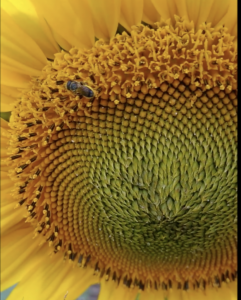Heriades truncorum, Large-headed resin bee, a specialist forager
I have had many reports over the years, usually from areas down in the south-east, regarding these bees using my Nurturing Nature solitary bee observation nest box. BWARS states that this bee is Oliogolectic on the pollen of yellow-flowered Asteraceae. Flowers such as asters, daisies or members of the sunflower family. Why has it limited itself to this flower family? You will see why shortly!
Transportation of pollen
This small elongated bee, unlike honey or bumblebees, does not store pollen inside a pollen basket (corbicula) on each leg to carry pollen when out foraging to provision for its larvae back at its nest. Nor does it carry the pollen internally like Hylaeus communis, Common yellow face bee. Instead, it carries it underneath its abdomen, using a dense mass of stiff hairs, (scopa) which is used to transport the pollen. As do may other cavity-nesting solitary bees.
The importance of pollen
Pollen is the primary protein and nutrient source for bees and they obtain it by visiting flowers. It is used to feed their larvae in their natal nests. But there are so many flowers with so many ways of displaying their pollen. Hence bees have evolved many different behaviours and tactics to collect it. Cane describes one method as ‘buzz milking’ whereby the bee curls around the anthers and buzzes. This is a phase I have not heard before.
How does pollen stick to the scopa?
When flying insects fly through the air, they develop a positive charge on their bodies because of friction between their bodies and air molecules which rubs of electrons. Basically the positively charged bee attracts the negatively charged pollen on the flowers it lands on. This is called electrostatic attraction of the pollen grains to the bee’s body, hairs and each other. However, would that static-like electricity be enough to hold the pollen grains securely especially as the bee will fly laden with it and open to air currents and disturbance? Nature has thought of this and the adhesion to its body is also helped by an oily, sticky and usually yellow material known as Pollenkitt.

Heriades truncorum gathering pollen
How do bees obtain the pollen?
Different species have evolved numerous different methods of efficiently harvesting large amounts of pollen to transport back to their natal nest in large loads. Even on the same flowers used by other bees, they will use different pollen gathering methods. Scientists when looking at this behaviour have coined a lot of different terms. I will list these as they are interesting but also confusing! Scrabbling, stroking, raking, scraping, brushing, wiping, buzz pollination, floral sonication, tapping, patting, drumming, thumping, active and incidental pollen gathering,
Active pollen gathering behaviours can be broken up into six types, listed loosely in order of prevalence:
- Scraping with the extremities: use of the legs or mouthparts to remove pollen directly from anthers, or, less commonly, to glean pollen from flowers.
- Buzzing: use of the flight muscles to vibrate a flower to assist with pollen release.
- Rubbing with the body and/or scopa(e): the gathering of pollen through direct and more or less continuous contact with the anthers by the main trunk of the body (thorax, abdomen) and/or the scopal hairs.
- Tapping: picking up pollen from anthers by a rapid up and down motion of the abdominal venter.
- Rubbing with the face: continuous and more or less direct contact with the anthers by the face.
- Rasping: rubbing of the thoracic dorsum against anthers, causing the anthers to vibrate and release the pollen.
Incidental pollen gathering (not broken down into types): the use of pollen that has accumulated on the body either through nectar gathering or on non-target areas as a result of a primary pollen gathering behaviour. A major component of incidental behaviour is the degree of movement by the bee, which influences the amount of pollen that adheres to the bee through contact.
Does our little bee vibrate the flowers, like a bumblebee? No. Does it drag its abdomen over pollen-laden florets like a magnet when drawn over iron filings? No. Does it collect it with its legs and groom the pollen under its body using its front, middle or hind legs? No. How does it get it pollen grains to ‘stick’ to those abdomen hairs? Does it do any of the six behaviours as above? Is it an incidental forager. I would suggest not based on the film below.
I would like to add another type of active pollen gathering. This bee manoeuvres its abdomen over the pollen and delicately and deliberately ‘dabs’ the pollen with its scopa under the abdomen.
Solitary Bees by Ted Benton I highly recommend
Steven Falk’s Field Guide to the Bees of Great Britain and Ireland is a must-have book if you want to ID bees and this extremely useful resource Steven Falk’s Flickr web site which furnishes extra photos and other useful resources to assist with identification.
For more info about wild bees see BWARS
Thanks to Dr Hauke Koch for confirming identification and HG for the film

Recent Comments